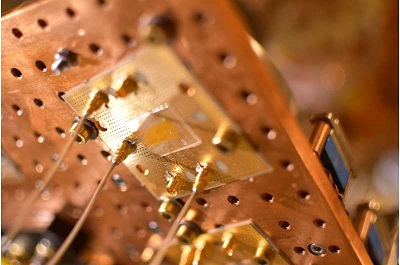
A chip that can control and modulate sound waves. Image credit: Shao Linbo/Harvard University
Scientists from Harvard University in the United States wrote in the latest issue of Nature Electronics magazine that they have demonstrated for the first time how to use electric fields to control and modulate sound waves on a chip, which is one step closer to the ultimate development of acoustic integrated circuits.
The researchers pointed out that although sound waves are slower than electromagnetic waves of the same frequency, they also have their own advantages: short sound waves are easily confined in nanoscale structures, do not easily "talk" to each other, and have strong interactions with the system that confines them, which makes them widely applicable to classical and quantum computing systems.
"Acoustic waves are promising information carriers for both quantum and classical information processing chips, but scientists have been unable to control them in a low-loss, scalable way, which has hampered the development of acoustic integrated circuits," said Marco Ronca, a professor of electrical engineering at the Harvard School of Engineering and Applied Sciences (SEAS) and senior author of the latest study. "In this latest study, we demonstrated that acoustic waves can be controlled on an integrated lithium niobate platform, bringing us one step closer to acoustic integrated circuits."
Lonca and his team used the unique properties of lithium niobate to build an on-chip electroacoustic modulator to control the propagation of sound waves in an on-chip waveguide. The study showed that by applying an electric field, the modulator can control the phase, amplitude and frequency of the sound waves on the chip.
“This work advances the use of sound waves for both quantum and classical computing,” said Linbo Shao, a former SEAS postdoctoral fellow and first author of the paper. “Previous acoustic devices were passive, but now we can actively tune acoustic devices using electric fields. This paves the way for high-performance acoustic-wave-based devices and circuits that can be used for next-generation microwave signal processing, as well as on-chip quantum networks and interfaces that connect different types of quantum systems, including solid-state atomic systems and superconducting qubits.”
The researchers said that while they have only demonstrated a device on a chip, they are working to build more complex, large-scale acoustic wave circuits and interconnect with other quantum systems such as diamond color centers. Diamond color centers refer to nitrogen-vacancy color centers in diamond, which are the most common point defects in the diamond crystal structure and the most representative quantum system at present.
Previous article:GlobalWafers announces construction of new factory in Texas with monthly production capacity of 1.2 million wafers
Next article:Unveiling Samsung's mass-produced 3nm GAA technology
- ASML provides update on market opportunities at 2024 Investor Day
- It is reported that memory manufacturers are considering using flux-free bonding for HBM4 to further reduce the gap between layers
- Intel China officially releases 2023-2024 Corporate Social Responsibility Report
- Mouser Electronics and Analog Devices Launch New E-Book
- AMD launches second-generation Versal Premium series: FPGA industry's first to support CXL 3.1 and PCIe Gen 6
- SEMI: Global silicon wafer shipment area increased by 6.8% year-on-year and 5.9% month-on-month in 2024Q3
- TSMC's 5nm and 3nm supply reaches "100% utilization" showing its dominance in the market
- LG Display successfully develops world's first stretchable display that can be expanded by 50%
- Infineon's revenue and profit both increased in the fourth quarter of fiscal year 2024; market weakness in fiscal year 2025 lowered expectations
- LED chemical incompatibility test to see which chemicals LEDs can be used with
- Application of ARM9 hardware coprocessor on WinCE embedded motherboard
- What are the key points for selecting rotor flowmeter?
- LM317 high power charger circuit
- A brief analysis of Embest's application and development of embedded medical devices
- Single-phase RC protection circuit
- stm32 PVD programmable voltage monitor
- Introduction and measurement of edge trigger and level trigger of 51 single chip microcomputer
- Improved design of Linux system software shell protection technology
- What to do if the ABB robot protection device stops
- CGD and Qorvo to jointly revolutionize motor control solutions
- CGD and Qorvo to jointly revolutionize motor control solutions
- Keysight Technologies FieldFox handheld analyzer with VDI spread spectrum module to achieve millimeter wave analysis function
- Infineon's PASCO2V15 XENSIV PAS CO2 5V Sensor Now Available at Mouser for Accurate CO2 Level Measurement
- Advanced gameplay, Harting takes your PCB board connection to a new level!
- Advanced gameplay, Harting takes your PCB board connection to a new level!
- A new chapter in Great Wall Motors R&D: solid-state battery technology leads the future
- Naxin Micro provides full-scenario GaN driver IC solutions
- Interpreting Huawei’s new solid-state battery patent, will it challenge CATL in 2030?
- Are pure electric/plug-in hybrid vehicles going crazy? A Chinese company has launched the world's first -40℃ dischargeable hybrid battery that is not afraid of cold
- ZigBee Power Consumption Calculation
- When burning the program, you mistakenly select "cold start" and the program can only be downloaded when P3.2/P3.3 is 0/0. Solution
- Buy OBD source code
- Problem of True RMS Conversion of Sine Wave
- RK3399 Science Section丨OK3399-C Development Board + RK1808 AI Compute Stick (Active Mode)
- stm8s serial communication cannot detect the port
- Detailed capture of msp430g2553
- EEWORLD University Hall - Wildfire uCOS-III Kernel Implementation and Application Development Practical Guide
- mDNS http server redundant array
- Circuit design, simulation and PCB design - from analog circuits, digital circuits, RF circuits, control circuits to signal integrity...

 System Management Bus 3.2
System Management Bus 3.2















 京公网安备 11010802033920号
京公网安备 11010802033920号